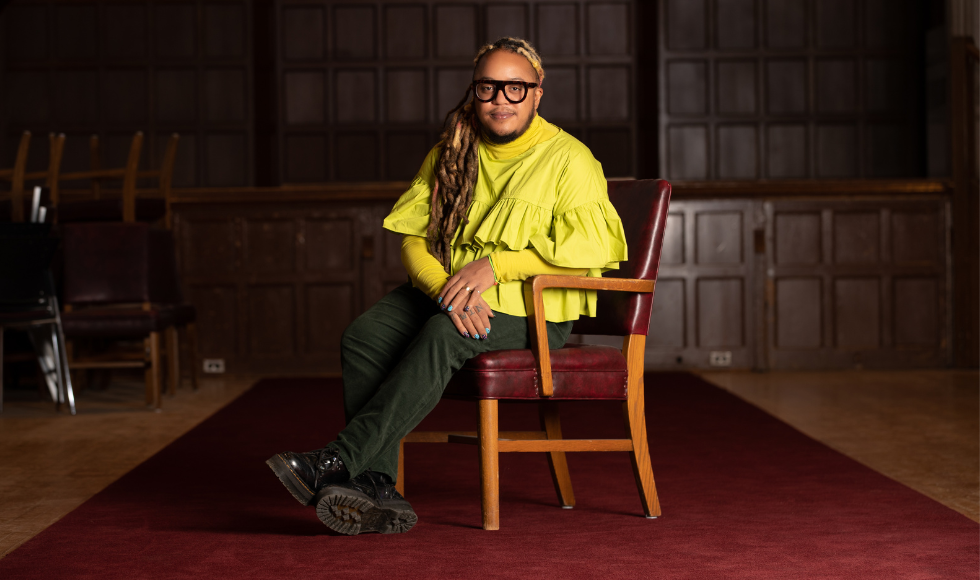Book empowers children to explore a better future through themes of justice, conflict and community

Syrus Marcus Ware, an assistant professor in McMaster's School of the Arts, is the author of Abolition is Love, a children's book that explores themes of justice, conflict and community. (Photo by Georgia Kirkos/McMaster University).
BY Sara Laux
February 7, 2024
Over a cup of breakfast coffee in June 2020, Syrus Marcus Ware realized that the topic of prison abolition had officially reached the mainstream: he saw an article about it in Cosmopolitan magazine.
At that point, Ware, an assistant professor in the School of the Arts and the co-founder of Black Lives Matter Canada, had been deeply involved in both the defund the police movement and with prison abolition for many years. Following the widespread uprisings in June and July of 2020 after the murder of George Floyd in Minneapolis, it seemed as though abolition had finally become a topic for mass media.
“I’ve been an abolitionist for 26 years, and for a lot of that time, the topic was a complete non-starter,” he says. “Not that we should get advice about abolition from Cosmo, of course, but the fact that it was in the zeitgeist and the conversation was happening on such a broad scale was interesting.”
That Cosmo article got him thinking. Sure, the conversation was happening among adults. But what was the best way to talk about some of those big ideas with kids? And what did they need to know and learn to do if a better future was actually going to happen?
The answer was Abolition is Love, a 36-page children’s book written by Ware and illustrated by Alannah Fricker that’s aimed at kids from preschool to grade two.
Published in September 2023 by Triangle Square, an imprint of Seven Stories Press, the book launched at this year’s Toronto International Festival of Authors and has since been included on “best books” lists from CBC and the Globe and Mail.
The story follows Amelie, whose family is getting ready for a vigil to mark Prisoners’ Justice Day, which is held annually on August 10. As the book progresses, Amelie learns to resolve a conflict with a cousin, helps create a beautiful banner, and looks forward to holding a candle at the rally – ultimately realizing that small, everyday choices can help build a better world of love, justice and care.
“I wanted to write a book that helped kids to think through how to deal with conflict when it happens, and to imagine for themselves how they might respond,” Ware explains.
“Because if we don’t talk about it when they’re young, when are we going to talk to them? Kids experience conflict all the time – why not give them the tools to deal with it?”
Of course, in a children’s book, illustrations go hand in hand with the text – and Ware points out that Alannah Fricker’s vibrant, colourful pictures both key intimate family moments as well as big, complex community activities that show abolition in practice.
What’s more, the illustrations show situations not often depicted in other books aimed at young kids – but that reflect an important part of some children’s lives.
“There’s a scene in a jail, so readers get to see that experience,” explains Ware. “This is a way into the story for kids who may have a family member or loved one who’s been incarcerated, but whose experience has never really been part of story time. Their reality is written into this story.
“For a lot of the communities I’ve engaged with, this book is a welcome resource rather than a challenge to the status quo.”
Alongside dealing with here and now ideas, Ware also hopes that Abolition is Love sparks inspiration for the future – and for kids to realize that there’s a role for them to play in making that happen.
“We talk about disabled, Deaf and Mad futures, about futures that will be accessible,” he says. “We say we want to make futures where trans people live long enough to become elders. We want to make futures where there’s status for all and we’ve gotten rid of borders.
“How do we get there? We’re going to need everyone’s input, and everyone’s mind. Children have a totally different vantage point, and so we need to welcome their involvement and engagement in this kind of dreaming.”


